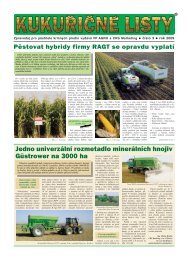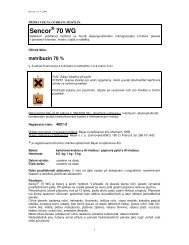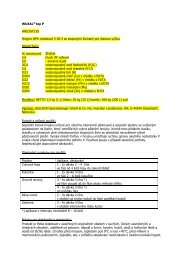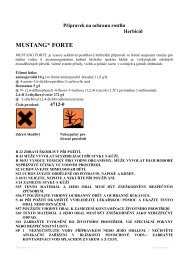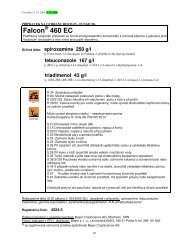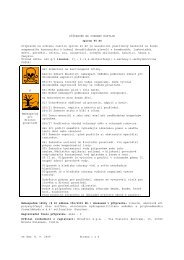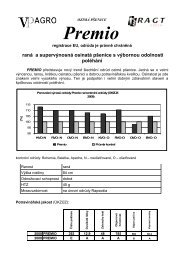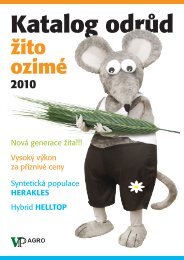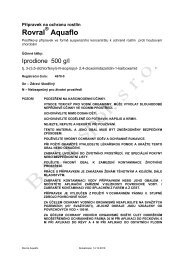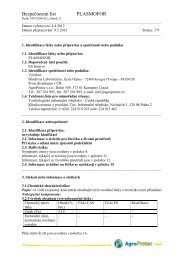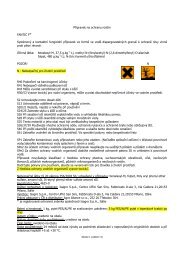Etiketa [.pdf] - DuPont
Etiketa [.pdf] - DuPont
Etiketa [.pdf] - DuPont
You also want an ePaper? Increase the reach of your titles
YUMPU automatically turns print PDFs into web optimized ePapers that Google loves.
A. Finoguenov et al. / Advances in Space Research 36 (2005) 622–625 625lies below our pressure model. The same clusters also revealan entropy which is much higher in the center,which may at least partly explain the effect. At radii beyond0.2r 500 , there is less scatter among the clusters andthe adopted pressure model performs well.Our main results are presented in Fig. 2 and imply:1. Strong deviations from the r 1.1 law are occurringinside 0.2r 500 for groups, while in regular clusterssuch deviations are generally confined to 0.1r 500(Pratt and Arnaud, 2003). It may indicate that theeffect of non-gravitational processes is important toa larger extent in the groups. However, similar levelof deviations is also present in the merger clusters.2. At radii 0.2 < r/r 500 < 0.6, the entropy profiles in thegroups are on average flatter than the r 1.1 law. Thisresult raises an interest in a systematic study ofentropy profiles at r/r 500 > 0.6. The level of theobserved flattening is around 100 keV cm 2 and couldbe related to the cooling threshold, discussed in Voitet al. (2003). At the same radii, the pressure profile ingroups is on average flatter than in clusters, which isseen as on average higher pressure at outskirts of thegroups compared to the model.3. A comparison between the prediction of the entropyaccording to the evolution of the shock heating in theKCDM Universe and the data can explain theentropy of the gas. The radial behavior of the entropyis flatter, compared to the index of 1.1–1.2 predictedin a hierarchical cluster growth with no feedbackeffects (Tozzi and Norman, 2001; Voit, in press). Thisresult implies that either the growth of clusters hasbeen slower or feedback effects are significant. Sloweraccretion rates support a suggestion of a dark energydominated Universe (Schuecker et al., 2003).4. At high redshift, the typical pressure of the gas isfound to be in agreement with prediction of the evolution,once a consistent definition of the mean temperaturehas been assumed for scaling. The effect ofenergy band in determining the mean temperatureshas been discussed in Zhang et al. (2004) in applicationto the REFLEX-DXL sample and by Mazzottaet al. (2004) in application to clusters in general.ReferencesBöhringer, H., Schuecker, P., Guzzo, L., et al. The ROSAT-ESO fluxlimited X-ray (REFLEX) galaxy cluster survey. V. The clustercatalogue. A&A 425, 367–383, 2004.Briel, U.G., Finoguenov, A., Henry, J.P. XMM-Newton EPICobservation of the galaxy cluster A 3667. A&A 426, 1–9, 2004.Dos Santos, S., Doré, O. Competition between shocks and entropyfloor: unifying groups and clusters of galaxies. A&A 383, 450–471,2002.Evrard, A.E., Henry, J.P. Expectations for X-ray cluster observationsby the ROSAT satellite. ApJ 383, 95–103, 1991.Finoguenov, A., Reiprich, T., Böhringer, H. Details of the mass–temperature relation for clusters of galaxies. A&A 368, 749–759,2001.Finoguenov, A., Jones, C., Böhringer, H., Ponman, T.J. ASCAobservations of groups at radii of low overdensity: implications forthe cosmic preheating. ApJ 578, 74–89, 2002.Finoguenov, A., Henriksen, M.J., Briel, U.G., de Plaa, J., Kaastra, J.S.XMM-Newton study of A3562 and its immediate Shapleyenvirons. ApJ 611, 811–820, 2004.Finoguenov, A., Boehringer, H., Zhang, Y.-Y. XMM-Newton studyof the two-dimensional structure of the REFLEX-DXL galaxyclusters. A&A, submitted-a.Finoguenov, A., Henriksen, M.J., Miniati, F., Briel, U.G., Jones, C.A.Puzzling merger in A3266: the hydrodynamic picture from XMM-Newton. ApJ, submitted-b.Henry, J.P., Finoguenov, A., Briel, U.G. Wide-field X-ray temperature,pressure, and entropy maps of A754. ApJ 615, 181–195, 2004.Jansen, F., Lumb, D., Altieri, B., et al. XMM-Newton observatory. I.The spacecraft and operations. A&A 365, L1–L6, 2001.Kaiser, N. Evolution and clustering of rich clusters. MNRAS 222,323–345, 1986.Kaiser, N. Evolution of clusters of galaxies. ApJ 383, 104–111, 1991.Mazzotta, P., Rasia, E., Moscardini, L., Tormen, G. Comparing thetemperatures of galaxy clusters from hydrodynamical N-bodysimulations to Chandra and XMM-Newton observations.MNRAS 354, 10–24, 2004.Mulchaey, J.S., Davis, D.S., Mushotzky, R.F., Burstein, D. An X-rayatlas of groups of galaxies. ApJS 145, 39–64, 2003.Osmond, J.P.F., Ponman, T.J. The GEMS project: X-ray analysis andstatistical properties of the group sample. MNRAS 350, 1511–1535, 2004.Ponman, T.J., Sanderson, A.J.R., Finoguenov, A. The Birmingham-CfA cluster scaling project – III. Entropy and similarity in galaxysystems. MNRAS 343, 331–342, 2003.Pratt, G.W., Arnaud, M. Entropy scaling in galaxy clusters: insightsfrom an XMM-Newton observation of the poor cluster A1983.A&A 408, 1–16, 2003.Rossetti, M., Molendi, S., Ghizzardi, S., Finoguenov, A. XMM/Chandra view of A3558. A&A, in preparation.Sanderson, A.J.R., Finoguenov, A., Mohr, J.J. AGN shock heating inthe cool core galaxy cluster Abell 478. ApJ (submitted). Availablefrom: .Schuecker, P., Caldwell, R.R., Böhringer, H., Collins, C.A., Guzzo, L.,Weinberg, N.N. Observational constraints on general relativisticenergy conditions, cosmic matter density and dark energy from X-ray clusters of galaxies and type-Ia supernovae. A&A 402, 53–63,2003.Tozzi, P., Norman, C. The evolution of X-ray clusters and the entropyof the intracluster medium. ApJ 546, 63–84, 2001.Voit, G.M., Balogh, M.L., Bower, R.G., Lacey, C.G., Bryan, G.L. Onthe origin of intracluster entropy. ApJ 593, 272–290, 2003.Voit, G.M., Ponman, T.J. Signatures of galaxy formation in theintracluster medium. ApJL 594, L75–L78, 2003.Voit, M.G. Tracing cosmic evolution with clusters of galaxies. Rev.Mod. Phys. (in press). Available from: .Zhang, Y.-Y., Finoguenov, A., Böhringer, H., et al. Temperaturegradients in XMM-Newton observed REFLEX-DXL galaxyclusters at z 0.3. A&A 413, 49–63, 2004.


![Etiketa [.pdf] - DuPont](https://img.yumpu.com/50853981/4/500x640/etiketa-pdf-dupont.jpg)
